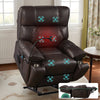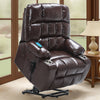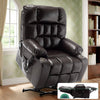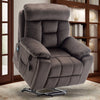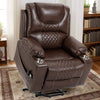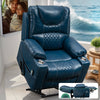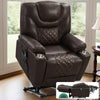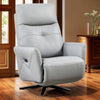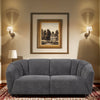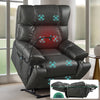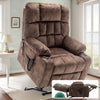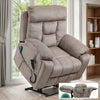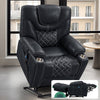Understanding Lift Chairs and Their Benefits for the Elderly
The Mechanism of Lift Chairs: How They Work
Lift chairs are specialized recliners designed to help seniors stand up easily. They have a motorized mechanism that tilts the chair forward. This lifting motion gently raises the user to a near-standing position. The user can control the chair's movement with a simple remote. Most lift chairs offer multiple positions for comfort. These include sitting, reclining, and even lying flat. The chairs use a powerful motor hidden in the base. This motor powers the smooth, quiet lifting action.

Advantages of Lift Chairs for Mobility Impairments
Lift chairs offer several benefits for seniors with mobility issues. They reduce the strain on joints and muscles when standing up. This is especially helpful for those with arthritis or weak legs. Lift chairs also promote independence. Seniors can sit down and stand up without assistance. This boosts confidence and reduces reliance on caregivers. Some models have extra features like heat and massage. These can help ease pain and improve circulation. Lift chairs also come in various sizes to fit different body types.
The Role of Lift Chairs in Fall Prevention
Fall prevention is a crucial aspect of senior care. Lift chairs play a significant role in this area. They eliminate the risky motion of pushing up from a seated position. This reduces the chance of losing balance and falling. The gradual lifting motion allows seniors to get their bearings before fully standing. Some lift chairs have safety features like backup batteries. These ensure the chair works even during power outages. By providing a stable platform for transitions, lift chairs can significantly lower fall risks at home.
Evaluating Senior Recliners: A Guide for Consumers
The Importance of Comfort and Ergonomics in Recliners for the Elderly
Comfort is key when choosing a recliner for seniors. Good ergonomics support proper posture and reduce pain. Look for chairs with adjustable headrests and lumbar support. The seat should be firm but cushioned to prevent sinking. Armrests should be at a comfortable height for relaxation. The footrest should fully support the legs when extended. Some recliners offer customizable settings for personal comfort. Memory foam padding can provide extra comfort for long sitting periods. Choose materials that are soft to the touch but durable and easy to clean.

Comparing Lift Chairs with Recliners: Features and Functionality
While both offer comfort, lift chairs and recliners have distinct features. Lift chairs provide the added benefit of assisted standing. Regular recliners require more strength to get in and out of. Lift chairs often have more position options than standard recliners. Some lift chairs can recline fully flat, which is rare in regular recliners. Recliners may be lighter and easier to move around the home. Lift chairs usually have more advanced features like USB ports and side pockets. Both types come in various styles to match home decor.
Senior Recliners vs. Lift Chairs: Cost and Lifestyle Fit
Cost is a major factor when choosing between lift chairs and recliners. Lift chairs are generally more expensive due to their motorized components. However, they may be covered by Medicare or insurance in some cases. Regular recliners are more affordable but offer fewer features. Consider the long-term value and potential healthcare savings of a lift chair. Think about the user's current and future mobility needs. A recliner might suffice for seniors who are still quite mobile. Those with progressive conditions may benefit more from a lift chair's features.
Choosing the Best Option: Combining Practicality and Comfort
Assessing Your Specific Needs and Living Space
Choosing the right chair starts with a clear assessment of needs. Consider the user's height, weight, and mobility level. Think about any specific health conditions that need support. Measure the available space in the room where the chair will go. Lift chairs need more room to operate fully. Check doorway widths if the chair needs to move between rooms. Consider the chair's primary use - for watching TV, reading, or napping. This will help determine the best features to look for.

Expert Tips on Selecting the Right Lift Chair or Recliner
Experts recommend trying chairs before buying if possible. Sit in the chair for at least 10 minutes to gauge comfort. Check that the controls are easy to use and reach. For lift chairs, test the lifting mechanism at different angles. Ensure the chair's back provides proper support when reclined. Look for sturdy construction and high-quality materials. Check warranty terms and after-sales support. Consider additional features like heat, massage, or USB charging ports. These can enhance the overall experience and usefulness of the chair.
How to Determine the Best Long-Term Investment for Elderly Care
When making a long-term investment in elderly care, think beyond immediate needs. Consider how the chair will accommodate changing mobility over time. A lift chair might be a better choice for progressive conditions. Look at the durability and expected lifespan of the chair. Higher upfront costs may be offset by longer use and better features. Consider the potential savings on caregiver assistance. A good chair can promote independence and reduce the need for help. Ultimately, the best investment balances current needs, future requirements, and overall quality of life improvements.


